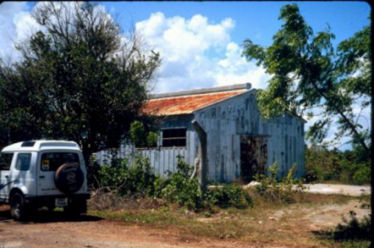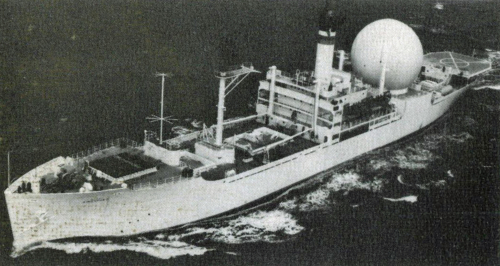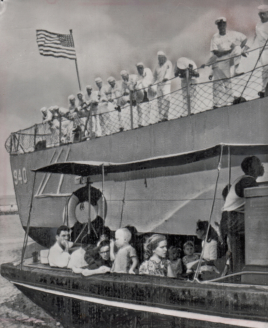All Rights Reserved, 2000 - 2017
Created by:
Torrence Royer
Comments are welcome.
Please leave a note in the public GUEST BOOK
or send a private Email to:
Barghash@msn.com

Project Mercury, Zanzibar
About
15km
east
of
Stone
Town,
near
the
village
of
Tunguu,
lie
the
rusting
remains
of
an
American
Space-Satellite
Tracking
Station.
This
Station
operated
in
Zanzibar
in
the
early
1960’s.
It
was
able
to
track
and
communicate
with
all
the
Project
Mercury
space
missions.
It
functioned
first
during
the
early
sub-orbital
launches,
when
American
astronauts
were
just
shot
into
space
in
a
parabolic
arc
from
Florida.
But
it’s
real
function
started
with
the
later
orbital-missions;
because
Zanzibar
lies
along
the
"Earth
Track"
of
those
satellites,
and
thus
Zanzibar
became
a
vital
link
in
the
world-wide
tracking
and
telemetry
network
that
communicated
and
controlled
these
space
craft.
Today
the
site
is
hard
to
find
but
if
one
turns
south,
off
the
road
from
Stone
Town
to
the
East
Coast,
just
before
it
reaches
Tunguu,
one
will
suddenly
come
upon
an
unusually
straight
road
that
leads
to
what
older
locals
still
call
"the
Americani
Buildings".
Best
preserved
of
these
is
the
Butler-
Aluminum
"Maintenance
Building",
that
once
contained
the
large
diesel
generator
used
to
power
the
Station.
Also,
nearby
is
the
"Dormitory
Building".
The
technicians
used
that
building
only
when
an
actual
mission
was
in
progress.
The
rest
of
the
time
the
Americans
lived
in
or
near
Stone
Town
with
their
families
and
blended
in
as
just
one
more
minority
in
cosmopolitan
Zanzibar.
The
high-tech
equipment,
and
the
‘reach
for
the
stars’
attitude’
intrigued
many
young
Zanzibaris.
I
recall
students
in
my
school
learning
the
schedules
of
the
satellite
launches
and
I
remember
young
people
would
lay
on
the
beach
at
night,
on
schedule,
looking
up,
waiting
for
the
spacecraft
to
pass
overhead.
One
friend
who
had
just
heard
about
this
phenomenon
joined
the
beach-watchers....
only
to
be
somewhat
disappointed
by
the
small
slow-moving
star-like
object
that
he
witnessed.
He
expected
a
close
fly-
by of a ‘flying saucer’ perhaps.
Another
person
who
was
moved
by
the
future-looking
nature
of
the
tracking
station
was
the
soon
to
be
famous
Farrokh
Bulsara.
After
the
revolution
he
moved
from
Zanzibar
to
Britain
and
became
the rock star
Freddy Mercury
.
Who knows if Mr. Bulsara was inspired to become Mr. Mercury due to this connection?




The
Zanzibar
tracking
station
was
part
of
the
first
real-time
global
communication
system
ever
built.
Prior
to
1960
such
long-distance
communication
was
done
via
a
network
of
land
based
and
undersea
telegraph
cables.
That
system
did
not
offer
the
reliability
or
real-time
capacity
that
was
needed
to
track
fast
moving
orbital
spacecraft.
When
the
United
States
decided
to
launch
manned
spaces
flights
it
soon
became
apparent
that
a
massive
project
was
needed
to
survey,
equip,
and
build
a
network
of
tracking
stations
around
the
world.
Despite
the
need
to
obtain
approval
from
seven
different
countries
to
build
these
sites,
all
the
tracking
stations
were
all
constructed in only two years.
Concerns
regarding
the
safety
of
the
astronauts
and
the
possible
need
to
control
the
spacecraft
from
the
ground,
if
the
Astronauts
became
incapacitated,
established
the
number
of
sites
needed.
It
was
decided
that
there
should
never
be
more
than
ten
minutes
‘flying
time’
between
the
control
capacity
of
one
ground
tracking
station
to
the
next.
That
decision
meant
that
a
total
of
16
tracking
stations
were
needed.
Two
were
to
be
on
ships
at
sea,
14
were
on
land,
half
of
them
in
foreign countries.
These sites were:
1.
Cape Canaveral
2.
Bermuda
3.
Gran Canaria (one of the Canary Islands)
4.
An Atlantic ship
5.
Kano (Nigeria)
6.
Zanzibar
7.
An Indian Ocean ship
8.
Muchea (in Western Australia)
9.
Woomera (in Southern Australia)
10.
Kanton (an island in Polynesia)
11.
Hawaii
12.
California
13.
Guayamas (Mexico)
14.
White Sands (New Mexico)
15.
Corpus Christi (Texas)
16.
Eglin AFB (Florida)

In
Zanzibar,
the
Sultan
was
one
of
the
first
world
leaders
to
declare
his
support
for
Project
Mercury
and
he
dedicated
land
for
the
site
near
the
center
of
the
main
island
near
the
village
named Tunguu.
There
were
actually
two
Project
Mercury
sites
on
Zanzibar.
The
manned
site
at
Tunguu
was
the
‘Receiver’
station
and
an
unmanned
site
near
the
east
coast
town
of
Chwaka,
was
the
‘Transmitter’ station.
These
tracking
stations
were
operated
and
maintained
year-round
by
technicians
working
for
the
Bendix
Radio
corporation,
an
American
company
that
had
a
contract
with
the
US
government.
Bendix
operated
other
similar
sites
around
the
world
with
their
employees
rotating
between
these
sites
occasionally.
NASA
employees
and
sometimes
an
astronaut
in
training
would
visit
these
sites,
usually when there was a mission in progress.
For
the
American
technicians,
Zanzibar
was
a
favored
assignment,
it
was
one
of
the
few
foreign
sites
where
families
could
accompany
the
workers.
It
was
considered
a
safe
environment
and
there had an American diplomatic Counsel on Zanzibar for over one hundred years.
The
resident
Americans
and
their
family
members
numbered
between
50
and
60
individuals
at
any
one
time.
They
lived
in
or
close
to
Zanzibar
City
and
commuted
from
there
to
the
Tunguu
site
on
what
were
then
excellent
roads.
Some
of
the
workers
were
radio
aficionados,
they
made
shortwave
broadcasts
from
Zanzibar
and
even
donated
and
installed
radio
equipment
in
the
wards
of the main hospital so that recuperating patients could listen to local news and music.

In
general,
the
Americans
maintained
good
relations
with
the
people
on
Zanzibar.
However,
in
the
political
campaigning
that
led-up
to
the
1961
Zanzibar
elections
the
tracking
station
became
a
political
issue.
The
ASP
party,
whose
symbol
was
the
Rooster,
argued
that
the
station
made
tiny
Zanzibar
a
target
in
any
nuclear
war
between
the
western
and
eastern
blocs.
Graffiti
appeared
on
buildings
showing
a
Zanzibar
rooster
pushing
an
American
cowboy
off
the
island.
Wild
claims
were made that the Telemetry Towers could be used to direct missiles towards Zanzibar..
[History
has
documented
the
peaceful
non-military
nature
of
Project
Mercury
but
at
the
height
of
the
‘Cold
War’
even
unfounded
fears
could
lead
to
real
anxiety
and
stress
on
Zanzibar.
The
situation
was
not
helped
by
the
fact
that
the
American
military
did
have
a
totally
unrelated
operation
named
Project
Condor,
part
of
which
involved
installing
‘Space
Targets’
on
the
ground
in
southwestern
United
States.
These
targets
were
used
for
calibrating
cameras
carried
in
military
satellites.
No
such
targets were ever built on Zanzibar.]
There
were
some
deadly
riots
and
British
troops
were
brought
in
to
keep
order.
Overt
violence
then ceased but political tensions simmered until the revolution occurred in early 1964.
When
the
Zanzibar
revolution
erupted
there
was
fighting
throughout
the
Island.
Some
witnessed
horrible
sights
but
no
American
was
harmed
on
the
day
of
the
rebellion.
However,
there
was
great
uncertainty
about
what
would
happen
next.
It
was
decided
that
there
might
be
safety
in
numbers,
the
Americans
therefore
organized
a
secret
convoy
of
vehicles
to
pick
up
all
the
technicians
from
their
scattered
homes
and
bring
them
to
a
central
location,
that
location
was
the
Africa
House
Hotel
, near the city harbor.
On
the
day
after
the
revolution
the
revolutionaries
agreed
to
allow
the
American
warship,
that
had
just
arrived
in
the
harbor,
the
Destroyer
USS
Manley
(DD-940)
,
to
send
a
small
boat
ashore
to
evacuate
the
American
citizens
and
some
others
who
also
worked
at
Project
Mercury.
A
total
of
91
people
were
swiftly
and
safely
evacuated,
54
were
Americans
and
37
were
“allied
nationals”.
(Some
say
a
Zanzibari
woman,
who
perhaps
had
dual
citizenship,
was
among
this
last
group.
She
was
said
to
be
the
mistress
of
a
senior
American.
A
very
awkward
moment
occurred
when she was put into the same evacuation lifeboat as that man and his wife.)



Not
all
Americans
left
on
the
USS
Manley.
Two
American
diplomats
remained,
and
they
helped
organize
a
local
crew
to
seal
the
Project
Mercury
buildings.
Over
the
next
weeks
relations
between
the
new
revolutionary
government
and
the
USA
continued
to
deteriorate.
Public
demonstrations against the Mercury Station were allowed in the streets of Stone Town.
The new Zanzibar Revolutionary
government, under President
Karume, then announced that
the site must be permanently
closed by end of April 1964.
The Americans were allowed to
dismantle the high-tech towers
and remove most of the
electronic equipment.
The Tunguu site now stands
abandoned, the rusted diesel
generator engines hauled away,
the main buildings completely
dismembered, for their
aluminum skin.
Today
only
parts
of
two
concrete
pillars,
that
held
a
large
elevated
fuel
tank,
remain
to
mark
this
location, where tiny Zanzibar once joined in the exploration of limitless confines of outer-space.






















































